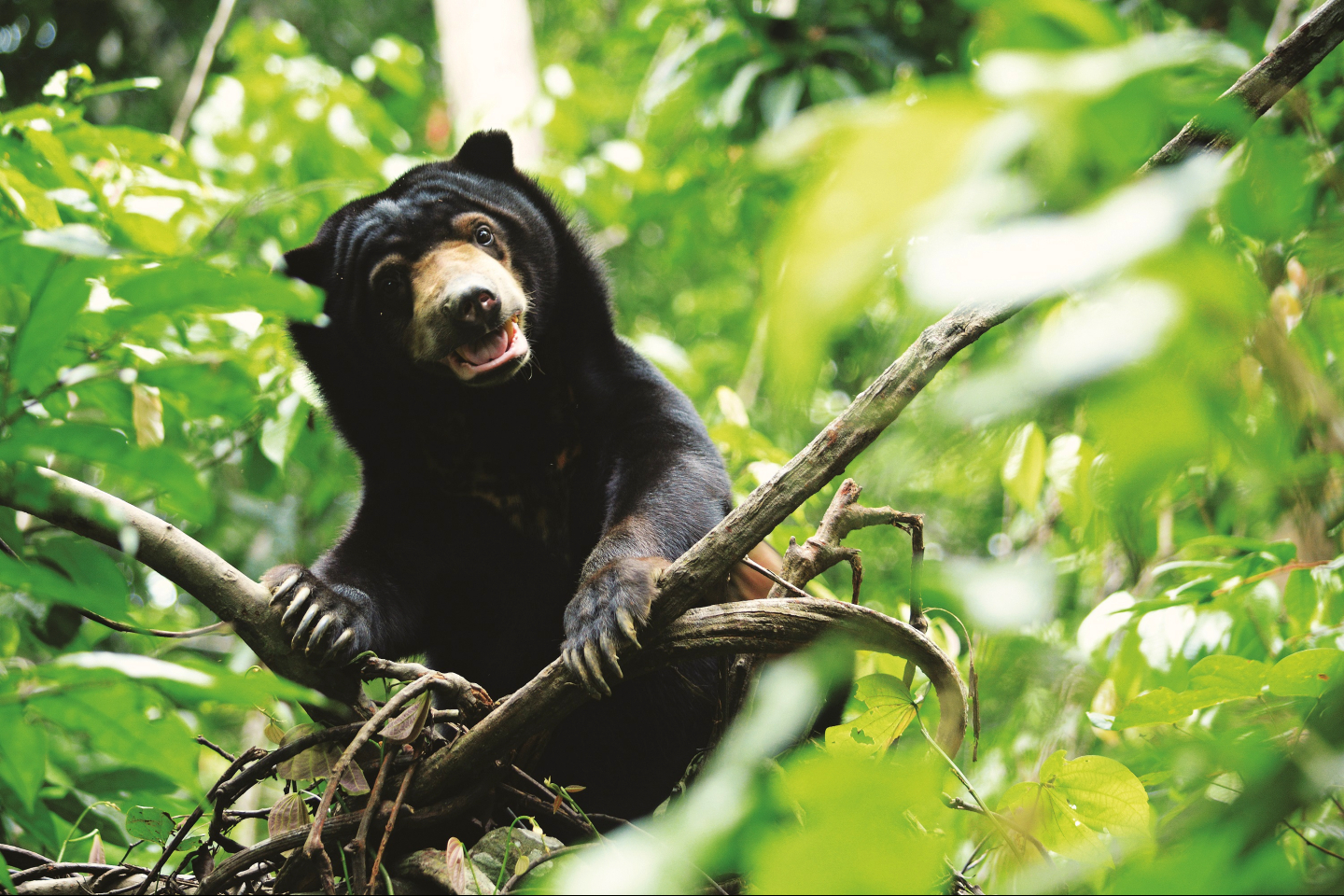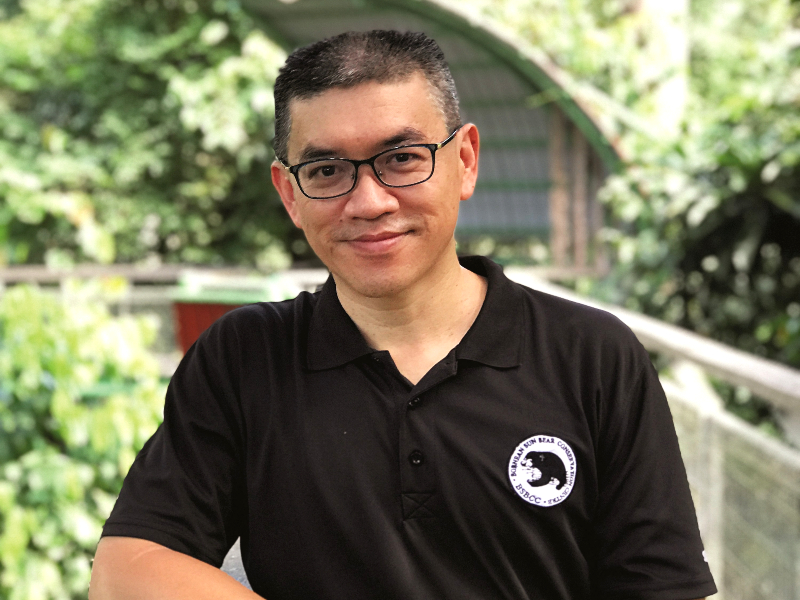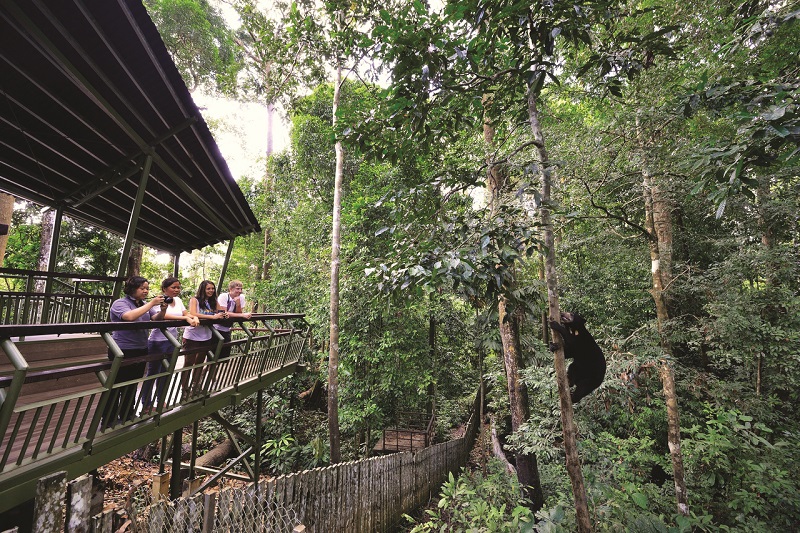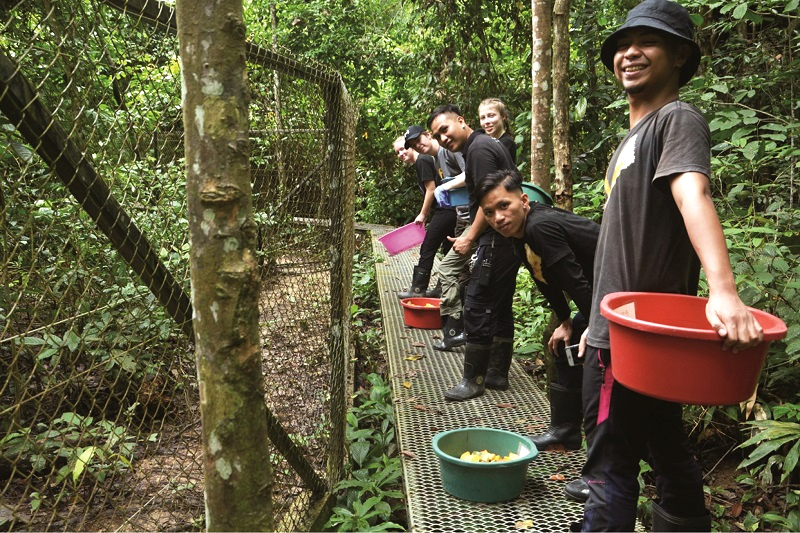
The global population of sun bears is estimated to have declined by 35% over the past three decades (All photos: Bornean Sun Bear Conservation Centre)
Dr Wong Siew Te’s career in conservation has taken him from one end of the country to another — born and raised in Bukit Mertajam, Penang, he has now made Sepilok, Sabah, his home as the founder and CEO of the Bornean Sun Bear Conservation Centre (BSBCC). In between, Wong spent time at Taiwan’s National Pingtung University of Science and Technology and the University of Montana in the US, and is now the pre-eminent expert on the Malayan sun bear, one of the least studied and second rarest bear species in the world. “I’ve travelled all over the world, but my speciality is a bear that’s very much local,” he quips.
Native to the tropical forests of Southeast Asia, sun bears get their name from a characteristic cream-coloured patch on their chests — no two markings are the same — and are responsible for dispersing seeds, keeping termite populations down, enhancing the nutrient cycle of the forests and creating nesting sites for animals such as hornbills and squirrels.
Sun bears are threatened by deforestation, illegal hunting for food and the wildlife trade; they are also harmed by conflicts with humans when they enter farmlands, plantations and orchards. Averaging just 130cm tall with a maximum weight of 70kg, sun bears are often kept as pets — the mothers are killed and the orphaned cub removed from the wild, then kept in small cages with grossly inadequate care.
The global population of sun bears is estimated to have declined by 35% over the past three decades, and they are declared by the International Union for Conservation of Nature as vulnerable. The objective of the BSBCC, which Wong founded in 2008, is to rehabilitate rescued sun bears to prepare them for life back in the forest so they may continue to play a critical role in our rainforest ecosystem.
img_2307_1.jpg

As a young boy, Wong had his sights set on animal conservation even before he knew what the phrase meant. His father’s fruit orchard was his gateway to nature and wildlife and, encouraged by his parents, he put in an application to study veterinary science at Universiti Putra Malaysia. He was not successful, so he went to Taiwan instead, but soon realised that the course he dreamt of pursuing was actually more geared towards livestock. But his time there was not wasted — he enjoyed parts of his coursework related to birdwatching, for example, and learnt a lot from saving wildlife that were often kept as pets in urban homes in 1980s Taiwan.
“Much of the wildlife I saw rescued was actually from Malaysian forests,” he recalls. “That really sharpened my focus, and I went to the US to further my passion for conservation. At university, I came across a professor who was looking for a Malaysian student to aid his research in sun bears.” This would turn out to be a life-changing event for Wong, who eventually completed his master’s degree on the topic — his thesis was on the ecology of Malayan sun bears in the forests of Borneo.
Wong’s career as a biologist and sun bear researcher would hit many other milestones as he worked on establishing the BSBCC. In 2014, he received the Outstanding Alumni Award from his Taiwanese alma mater. In 2016, he was given an honorary doctorate from University of the Sunshine Coast, Australia, in recognition of his lifelong contribution to sun bear conservation in Southeast Asia. A year later, he was named Wira Negaraku by the Malaysian Prime Minister’s Office and nominated as a CNN Hero.
edm_8885.jpg

Founded with the help of Land Empowerment Animals People, the Sabah Wildlife Department and the Sabah Forestry Department, BSBCC occupies a 5ha space previously earmarked for a rhinoceros rehabilitation centre, which unfortunately could not be opened as the animals had died. BSBCC was built in four phases, designed to create a safe enclosure for the bears that allows visitors to view them from a distance. The layout, modelled after the nearby Sepilok Orangutan Rehabilitation Centre, made the centre a magnet for overseas researchers as well, as there was nothing like BSBCC anywhere else in the world.
“The centre is based on five pillars — sun bear rescues, rehabilitation where possible, continued research, education and ecotourism,” says Wong, who set up the centre with a lot of his own funds. “In 2014, we opened to the public as an ecotourism-based centre so it would be financially sustainable, and also encourage education and learning. We have in total rescued 65 rescued bears, and 10 have been released into the wild.
"The plan is to expand the centre to include three more pillars that will not only grow the sun bear population, but also that of other wildlife — captive breeding, anti-poaching campaigns and forest connectivity, which creates corridors between forest islands so wildlife has a larger space to roam.”
Wong’s 10-year plan for BSBCC has unfortunately been affected quite dramatically by the Covid-19 pandemic and the resulting travel restrictions — visitors, researchers and documentary filmmakers have all stopped coming, which also means funding for the centre has dropped to zero.
volunteers_interns_1.jpg

“In pre-pandemic times, we were doing very well and were able to easily manage our monthly costs of RM120,000. But in the last one year, we have completely lost our revenue sources. After dipping into reserves for a while, we have resorted to asking for donations. I am very grateful for the help we received from Sime Darby and Yayasan Hasanah, but we do need a sustainable plan,” he says, a little wearily. Members of the public who are keen to help can make cash donations, purchase merchandise from the BSBCC online gift shop or adopt a bear to pay for its care.
Wong is remarkably optimistic despite the circumstances he and the centre are up against, and is already planning for the future. “A satellite sun bear centre at the Tabin Wildlife Sanctuary,” he says excitedly. Occupying a large part of the peninsula forming the northern headland of Darvel Bay, it is located 48km east of Lahad Datu. “The focus will be more on research and less on ecotourism, but it means we can expand the number of bears we can save and rehabilitate.”
The opening of this satellite centre will depend on many factors, including the loosening of Covid-19-related restrictions, an increase in domestic tourism ahead of borders opening up for international travel and, of course, funding.
The focus for the present remains the main centre in Sepilok, and keeping its 44 bears and 24 members of staff safe as well. “Right now, the team and I are going all out to get more funds because no matter what, the centre must remain open,” Wong says emphatically. May it be so, sir — may it be so.
This article first appeared on July 26, 2021 in The Edge Malaysia.


